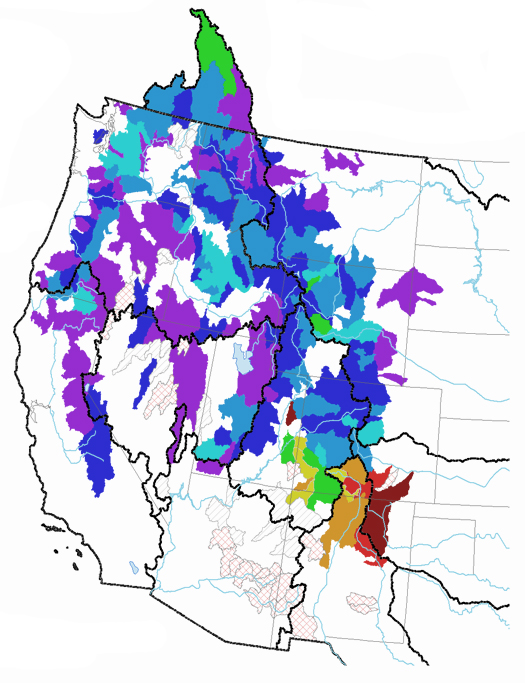
[Flaming Gorge Reservoir on the Green River in Utah; the reservoir’s primary dam is highlighted in red. In anticipation of record summer floods, the reservoir’s waters are “being released as fast as [they] can flow”, making space in the reservoir to hold snowmelt. Downstream, rafters are finding that typical rafting trips of two-and-a-half hours are shortened to a mere thirty minutes.]
As the month-long deluge ends and the Mississippi River flood crests (which is not at all the same as saying the flooding is ending), a separate flooding threat has quietly piled up in the Mountain West:
“Thanks to a blizzard-filled winter and an unusually cold and wet spring, more than 90 measuring sites from Montana to New Mexico and California to Colorado have record snowpack totals on the ground for late May, according to a federal report released last week. Those giant and spectacularly beautiful snowpacks will now melt under the hotter, sunnier skies of June — mildly if weather conditions are just right, wildly and perhaps catastrophically if they are not. Fear of a sudden thaw, releasing millions of gallons of water through river channels and narrow canyons, has disaster experts on edge.
…the West has changed significantly since 1983, when super-snows last produced widespread flooding. From the foothills west of Denver to the scenic, narrow canyons of northern Utah, flood plains that were once wide-open spaces have been built up. Many communities have improved their defenses, for example, by fortifying riverbanks to keep streams in place, but those antiflood bulwarks have for the most part not been tested by nature’s worst hits. And in sharp contrast to the floods on the Mississippi River — one mighty waterway, going where it will — the Western story is fragmented, with anxiety dispersed across dozens, perhaps even hundreds, of large and small waterways that could surge individually, collectively or not at all.”
While spring floods have already inundated parts of the Mountain West, the massive pile-up of mountain snow has the potential to create another order of disaster. Many, if not a majority, of Western snowpack measurement sites show twenty-year records. A map from the National Water and Climate Center indicates the extremity of the condition:

Areas shown from light blue to purple possess snowpack at least 110 percent of average; purple indicates the greatest variation above average — 180 percent or more. Randy Julander of the Natural Resources Conservation Service colorfully described the situation to the Seattle Post Intelligencer:
“At this point, everybody is just sitting back chewing fingernails and waiting because the longer it stays cold and wet, the worse it’s going to get…”
Julander said in a typical year the weather warms gradually, allowing snow in the mountains to melt slowly and ease into rivers and streams over time. That’s not the case this year.
“June is right around the corner and sooner or later, it’s going to warm up,” he said, noting that instead of gradually warming over eight to ten weeks, the West will likely see a rapid rise in temperatures heading into summer, a worst case scenario.
“And it’s not just Utah, Colorado and Wyoming. It’s basically all of the western states except Arizona and New Mexico,” Julander said. “We’re waiting for the chute to open and the bull to come out bucking, but he ain’t moving, yet.”
[Link to New York Times article via Nam Henderson.]


[…] I mentioned back in May, massive snowpack in the Rockies is melting to produce volumes of water that will continue to push […]